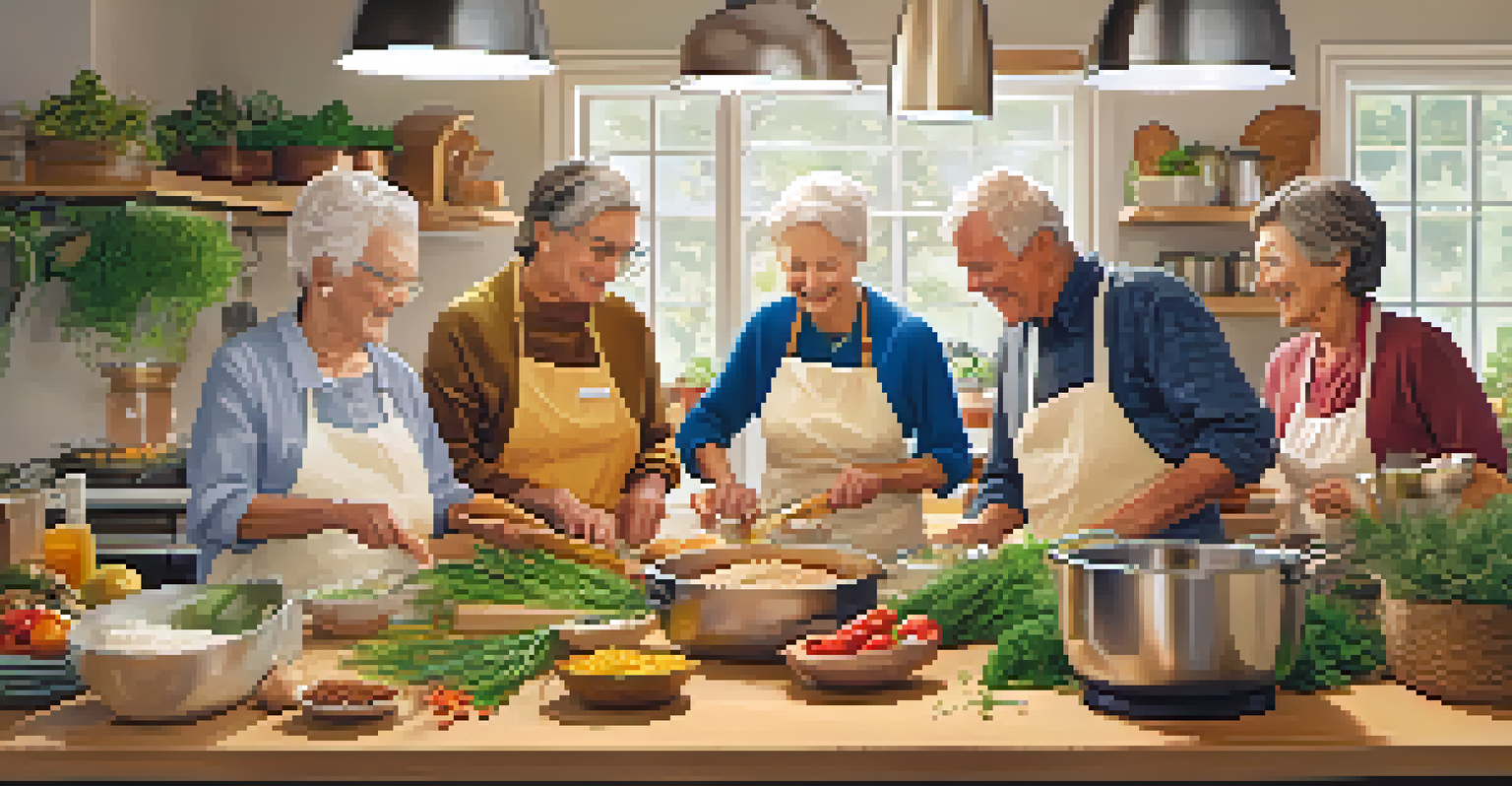Culinary Medicine for Seniors: Nutrition and Cooking Tips

Understanding Culinary Medicine and Its Importance for Seniors
Culinary medicine blends the art of cooking with the science of nutrition, particularly important for seniors. As we age, our nutritional needs change, making it crucial to understand how food affects our health. This approach empowers older adults to make informed dietary choices that can enhance their well-being.
Let food be thy medicine and medicine be thy food.
By focusing on whole foods, seniors can better manage chronic conditions like diabetes and heart disease. Culinary medicine emphasizes not just what we eat but also how we prepare and enjoy our meals. This holistic approach can lead to healthier eating habits and improved quality of life.
Moreover, cooking can be a joyful and social activity, bringing families and friends together. Incorporating culinary medicine into daily routines can foster community and connection, which are vital for emotional health as we age.
Key Nutritional Needs for Seniors: What to Consider
As seniors age, their bodies require different nutrients to maintain optimal health. Key nutrients include protein for muscle maintenance, fiber for digestive health, and calcium and vitamin D for bone strength. Understanding these needs can help seniors make better food choices.

Hydration is also crucial; many older adults forget to drink enough water, leading to dehydration. Ensuring that meals are not only nutritious but also hydrating can help in maintaining overall health. Foods like soups, fruits, and vegetables can aid in this effort.
Culinary Medicine Benefits Seniors
This approach empowers older adults to make informed dietary choices that enhance their well-being.
It's essential to consider any specific dietary restrictions or health conditions, such as hypertension or kidney disease. Tailoring meal plans to accommodate these needs can lead to a more balanced and enjoyable diet.
Easy Cooking Techniques for Seniors: Keeping It Simple
Simplicity is key when it comes to cooking for seniors. Techniques like steaming, roasting, and slow-cooking can enhance flavors without requiring intricate skills. These methods not only make cooking easier but also preserve nutrients in food, making meals healthier.
Cooking is like love. It should be entered into with abandon or not at all.
Using one-pot meals can be a game-changer, reducing both preparation and clean-up time. For instance, a hearty vegetable stew or a simple pasta dish can be nutritious and satisfying. This approach encourages experimentation with different ingredients without overwhelming complexity.
Incorporating tools like slow cookers or air fryers can also ease the cooking process. These appliances can help seniors prepare meals with minimal effort while still enjoying a variety of flavors and textures.
Incorporating More Fruits and Vegetables into Meals
Fruits and vegetables are powerhouses of nutrition, packed with vitamins, minerals, and antioxidants. For seniors, incorporating these foods into meals can boost overall health and help prevent chronic diseases. Simple strategies, like adding spinach to omelets or berries to yogurt, can make a significant difference.
Experimenting with different colors and types of produce can also keep meals interesting. A colorful plate not only looks appealing but also indicates a variety of nutrients. Seniors can take advantage of seasonal produce, which is often fresher and more flavorful.
Simplicity in Cooking Techniques
Using simple cooking methods like steaming and one-pot meals makes nutritious cooking more accessible for seniors.
Additionally, preparing fruits and vegetables in advance can encourage healthier snacking. Washing and chopping veggies for easy access or making fruit salads can help seniors choose nutritious options over processed snacks.
Understanding Portion Sizes: Eating Mindfully
As metabolism slows with age, understanding portion sizes becomes increasingly important. Eating mindfully can help seniors enjoy their meals while avoiding overeating. A helpful tip is to use smaller plates and bowls to create the illusion of a fuller plate.
Listening to the body's hunger cues is another essential aspect of mindful eating. Seniors should focus on eating when they are hungry and stopping when they feel satisfied, rather than following strict meal schedules. This approach can promote healthier eating habits and better digestion.
Incorporating a variety of foods in smaller portions can also help with achieving a balanced diet. Mixing different food groups ensures that seniors receive the necessary nutrients without feeling overwhelmed by large servings.
Managing Dietary Restrictions: Adapting Recipes for Health
Many seniors face dietary restrictions due to health conditions, which can complicate meal planning. However, with some creativity, it's possible to adapt favorite recipes to meet these needs. For instance, using herbs and spices can enhance flavor without adding extra salt for those with hypertension.
Substituting ingredients can also make recipes healthier. For example, using whole grain pasta instead of regular pasta can increase fiber intake, while swapping out cream for Greek yogurt can reduce calories and fat. These small changes can have a significant impact on overall health.
Social Connections Through Meals
Cooking and sharing meals fosters emotional well-being and strengthens social ties among seniors.
It's essential to involve seniors in the cooking process, allowing them to express their preferences while adhering to dietary guidelines. This collaboration can foster independence and encourage a more positive relationship with food.
Encouraging Social Connections Through Cooking and Eating
Cooking and sharing meals with others can significantly enhance a senior's emotional well-being. Social connections are vital for mental health, and mealtime provides an excellent opportunity for bonding. Whether it's a family dinner or a potluck with friends, these gatherings can create cherished memories.
Involving seniors in community cooking classes or meal prep sessions can also foster a sense of belonging. These activities promote interaction and provide an opportunity to learn new recipes and cooking techniques together. Plus, they can help combat feelings of isolation.

Additionally, exploring cultural cuisines can be a fun way to broaden culinary horizons. Trying new dishes from different cultures can spark conversations and encourage sharing of family traditions, making meals more meaningful.